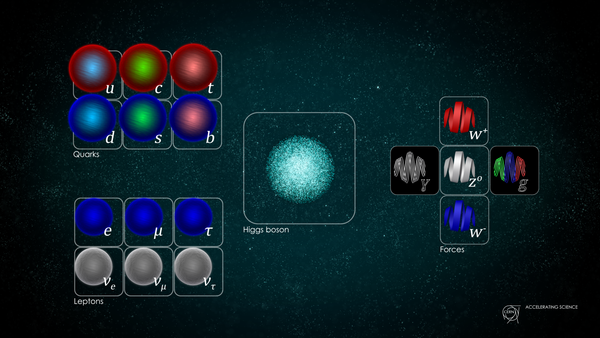My heart of physics
Every July 4, I have occasion to remember two things: the discovery of the Higgs boson, and my first published byline for an article about the discovery of the Higgs boson. I have no trouble believing it’s been eight years since we discovered this particle, using the Large Hadron Collider (LHC) and its ATLAS and CMS detectors, in Geneva. I’ve greatly enjoyed writing about particle physics in this time, principally because closely engaging with new research and the scientists who worked on them allowed me to learn more about a subject that high school and college had let me down on: physics.
In 2020, I haven’t been able to focus much on the physical sciences in my writing, thanks to the pandemic, the lockdown, their combined effects and one other reason. This has been made doubly sad by the fact that the particle physics community at large is at an interesting crossroads.
In 2012, the LHC fulfilled the principal task it had been built for: finding the Higgs boson. After that, physicists imagined the collider would discover other unknown particles, allowing theorists to expand their theories and answer hitherto unanswered questions. However, the LHC has since done the opposite: it has narrowed the possibilities of finding new particles that physicists had argued should exist according to their theories (specifically supersymmetric partners), forcing them to look harder for mistakes they might’ve made in their calculations. But thus far, physicists have neither found mistakes nor made new findings, leaving them stuck in an unsettling knowledge space from which it seems there might be no escape (okay, this is sensationalised, but it’s also kinda true).
Right now, the world’s particle physicists are mulling building a collider larger and more powerful than the LHC, at a cost of billions of dollars, in the hopes that it will find the particles they’re looking for. Not all physicists are agreed, of course. If you’re interested in reading more, I’d recommend articles by Sabine Hossenfelder and Nirmalya Kajuri and spiralling out from there. But notwithstanding the opposition, CERN – which coordinates the LHC’s operations with tens of thousands of personnel from scores of countries – recently updated its strategy vision to recommend the construction of such a machine, with the ability to produce copious amounts of Higgs bosons in collisions between electrons and positrons (a.k.a. ‘Higgs factories’). China has also announced plans of its own build something similar.
Meanwhile, scientists and engineers are busy upgrading the LHC itself to a ‘high luminosity version’, where luminosity represents the number of interesting events the machine can detect during collisions for further study. This version will operate until 2038. That isn’t a long way away because it took more than a decade to build the LHC; it will definitely take longer to plan for, convince lawmakers, secure the funds for and build something bigger and more complicated.
There have been some other developments connected to the current occasion in terms of indicating other ways to discover ‘new physics’, which is the collective name for phenomena that will violate our existing theories’ predictions and show us where we’ve gone wrong in our calculations.
The most recent one I think was the ‘XENON excess’, which refers to a moderately strong signal recorded by the XENON 1T detector in Italy that physicists think could be evidence of a class of particles called axions. I say ‘moderately strong’ because the statistical significance of the signal’s strength is just barely above the threshold used to denote evidence and not anywhere near the threshold that denotes a discovery proper.
It’s evoked a fair bit of excitement because axions count as new physics – but when I asked two physicists (one after the other) to write an article explaining this development, they refused on similar grounds: that the significance makes it seem likely that the signal will be accounted for by some other well-known event. I was disappointed of course but I wasn’t surprised either: in the last eight years, I can count at least four instances in which a seemingly inexplicable particle physics related development turned out to be a dud.
The most prominent one was the ‘750 GeV excess’ at the LHC in December 2015, which seemed to be a sign of a new particle about six-times heavier than a Higgs boson and 800-times heavier than a proton (at rest). But when physicists analysed more data, the signal vanished – a.k.a. it wasn’t there in the first place and what physicists had seen was likely a statistical fluke of some sort. Another popular anomaly that went the same way was the one at Atomki.
But while all of this is so very interesting, today – July 4 – also seems like a good time to admit I don’t feel as invested in the future of particle physics anymore (the ‘other reason’). Some might say, and have said, that I’m abandoning ship just as the field’s central animus is moving away from the physics and more towards sociology and politics, and some might be right. I get enough of the latter subjects when I work on the non-physics topics that interest me, like research misconduct and science policy. My heart of physics itself is currently tending towards quantum mechanics and thermodynamics (although not quantum thermodynamics).
One peer had also recommended in between that I familiarise myself with quantum computing while another had suggested climate-change-related mitigation technologies, which only makes me wonder now if I’m delving into those branches of physics that promise to take me farther away from what I’m supposed to do. And truth be told, I’m perfectly okay with that. 🙂 This does speak to my privileges – modest as they are on this particular count – but when it feels like there’s less stuff to be happy about in the world with every new day, it’s time to adopt a new hedonism and find joy where it lies.



